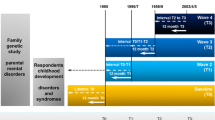Abstract
Objectives
To examine the clinical features and diagnostic stability of early-onset psychotic disorders.
Methods
These data are from a two-year longitudinal prospective study of youth with psychotic disorders. Standardized diagnostic assessments are administered at baseline and at one and two-year’s follow-up.
Results
Fifty-one subjects have been recruited to date; 18 with schizophrenia, 14 with bipolar disorder, 7 with schizoaffective disorder, 1 with an organic psychosis, and 11 subjects whose symptoms where either questionable and/or did not meet diagnostic criteria for another disorder (classified as psychosis nos). Thirty-nine subjects were reassessed at year one, twenty-four at year two. Three subjects have been lost to follow-up. The study diagnosis was the same as the first onset diagnosis (prior to entering the study) in 50% of subjects. Over the two-year period of the study, the diagnosis remained unchanged in over 90% of subjects.
Subjects with schizophrenia had higher ratings of premorbid impairment, including social withdrawal and dysfunctional peer relationships, than those with bipolar disorder. At the one-year follow-up, subjects with schizophrenia and schizoaffective disorder had significantly higher rates of delusions, bizarre behavior, and negative symptoms than those with bipolar disorder. Subjects with bipolar disorder tended to have cyclical courses, whereas those with schizophrenia and schizoaffective disorder were often chronically impaired. Subjects with psychosis nos had higher rates of dissociative symptoms and histories of child maltreatment
Conclusions
Early-onset psychotic disorders can be reliably diagnosed using standardized assessments and are stable over a two-year period. Compared to bipolar disorder, schizophrenia is associated with a poorer premorbid history, and persistent positive and negative symptoms.
Similar content being viewed by others
References
Altman H, Collins M, Mundy P (1997) Subclinical hallucinations and delusions in nonpsychotic adolescents. Journal of Child Psychology and Psychiatry 38: 413–420
American Academy of Child and Adolescent Psychiatry (1997a) Practice parameter for the assessment and treatment of children and adolescents with bipolar disorder. Journal of the American Academy of Child and Adolescent Psychiatry 36 (10, Supplement): 177S-193S
American Academy of Child and Adolescent Psychiatry (1997b) Practice parameter for the assessment and treatment of children and adolescents with schizophrenia. Journal of the American Academy of Child and Adolescent Psychiatry 36 (10, Supplement): 157S-176S
American Psychiatric Association (1994) Diagnostic and statistical manual of mental disorders, fourth edition (DSM-IV). Washington, DC: American Psychiatric Association
American Psychiatric Association (1997) Practice guideline for the treatment of patients with schizophrenia. American Journal of Psychiatry 154: 4, Supplement
Andreasen N (1982) The scales for the assessment of positive and negative symptoms, University of Iowa, Iowa City, IA
Bernstein EM, Putnam FW (1986) Development, reliability and validity of a dissociative scale. Journal of Nervous and Mental Disease 174: 727–735
Cannon-Spoor HE, Potkin SG, Wyatt JR (1982) Measurement of premorbid adjustment in chronic schizophrenia. Schizophrenia Bulletin 8: 470–484
Carlson GA (1990) Child and adolescent mania: diagnostic considerations. J Child Psychol Psychiatry 31: 331–342
Carlson GA, Fennig S, Bromet EJ (1994) The confusion between bipolar disorder and schizophrenia in youth: where does it stand in the 1990’s. Journal of the American Academy of Child and Adolescent Psychiatry 33, 4: 453–460
Del Baccaro MA, Burke P, McCauley E (1988) Hallucinations in children: A follow-up study. Journal of the American Academy of Child and Adolescent Psychiatry 27: 462–465
Eggers C (1989) Schizo-affective psychosis in childhood: a follow-up study. J Autism Dev Disord 19: 327–334
Famularo R, Kinscherff R, Fenton T (1992) Psychiatric diagnoses of maltreated children. Preliminary findings. Journal of the American Academy of Child and Adolescent Psychiatry 31: 863–867
First MB, Gibbon M, Spitzer RL, Williams J (1996) User’s guide for the structured clinical interview for DSM-IV Axis I Disorders-Research Version. American Psychiatric Press, Inc., Washington, D.C.
Garralda ME (1984) Hallucinations in children with conduct and emotional disorders: I, The clinical phenomena. Psychological Medicine 14: 589–596
Garralda ME (1985) Characteristics of the psychoses of late onset in children and adolescents: a comparative study of hallucinating children. J Adolesc 8: 195–207
Hornstein NL, Putnam FW (1992) Clinical phenomenology of child and adolescent dissociative disorders. Journal of the American Academy of Child and Adolescent Psychiatry 31: 1077–1085
Kotsopoulos S, Kanigsberg J, Cote A, Fiedorowicz C (1987) Hallucinatory experiences in nonpsychotic children. Journal of the American Academy of Child and Adolescent Psychiatry 26: 375–380
McClellan JM, Werry JS, Ham M (1993) A follow-up study of early onset psychosis: comparison between outcome diagnoses of schizophrenia, mood disorders, and personality disorders. Journal of Autism and Developmental Disorders 23: 243–62
Reich W, Shayka JJ, Taibleson C (1991) Diagnostic interview for children and adolescents, revised. Washington University: St. Louis, Missouri
Shaffer D, Gould MS, Brasic J, Ambrosini P, Fisher P, Bird H, Aluwahlia S (1985) A children’s global assessment scale (CGAS). Psychopharmacology Bulletin 21: 747–748
Thomsen PH (1996) Schizophrenia with childhood and adolescent onset — a nation-wide register-based study. Acta Psychiatr Scand 94 (3): 187–93
Werry JS, McClellan J (1992) Predicting outcome in child and adolescent (earlyonset) schizophrenia and bipolar disorder. Journal of the American Academy of Child and Adolescent Psychiatry 31: 147–150
Werry JS, McClellan J, Chard L (1991) Early-onset schizophrenia, bipolar and schizoaffective disorders: a clinical followup study. J Am Acad Child Adolesc Psychiatry 30: 457–465
Author information
Authors and Affiliations
Corresponding author
Rights and permissions
About this article
Cite this article
McClellan, J., McCurry, C. Early onset psychotic disorders: Diagnostic stability and clinical characteristics. European Child & Adolescent Psychiatry 8 (Suppl 1), S13–S19 (1999). https://doi.org/10.1007/PL00010686
Issue Date:
DOI: https://doi.org/10.1007/PL00010686




